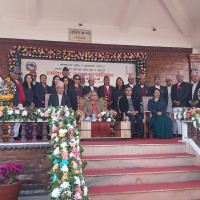- Thursday, 18 December 2025
Electrifying Last Mile In Sagarmatha’s Shadow
The Sagarmatha Region, home to Mount Everest, symbolises Nepal’s pride and global recognition. Annually, around 50,000 tourists from across the world visit this breathtaking landscape, captivated by its natural grandeur and cultural richness. Yet, in the shadow of these towering peaks, local communities have long lived without a reliable supply of electricity.
Despite their proximity to the world’s most iconic mountain peak, residents of the Solukhumbu district—especially those in high-altitude rural municipalities—face considerable barriers to accessing dependable power. In a world increasingly defined by electrification, digital connectivity, and climate change, such gaps present both a developmental and a moral challenge.
But a beacon of change is now emerging. The Amadablam Mini-Hydropower Project, currently under construction and scheduled to be completed by August 2026, in Khumbu Pasang Lhamu Rural Municipality, stands as a model for how innovative and collaborative approaches can electrify even the most remote corners of Nepal. The hydropower intake being built at 4,423 metres above sea level will be the highest-altitude hydropower station in the world upon completion.
Solukhumbu district was officially connected to Nepal’s national grid in December 2021. While this marked a milestone for the region, large sections beyond Lukla have not been electrified because of enormous technical and financial challenges. For many settlements in the high Himalayas, decentralised renewable energy solutions offer the most viable path forward.
Recognising this, the Government of Nepal—through the Alternative Energy Promotion Centre (AEPC)—has initiated the Amadablam Mini-Hydropower Project under the Nepal: Private Sector-Led Mini-Grid Energy Access Project (MGEAP), supported by the World Bank, and pushed forward to implementation with viability gap funding (VGF) support through Sustainable Energy Challenge Fund (SECF), under the auspices of UKAid-funded Nepal Renewable Energy Programme (NREP). The initiative underscores a new direction in Nepal’s electrification journey—one that is inclusive, climate-resilient and grounded in local ownership.
The project brings together government, community, private sector, and development partners in a truly collaborative effort. The Amadablam project will generate 911 kilowatts of electricity, directly benefiting 451 households and enterprises in Ward No. 4 of the Khumbu Pasang Lhamu Rural Municipality. These include hotels and lodges (86), restaurants (38), hospitals (2), and other vital institutions, shops, bakeries and recreation centers, as well as private households—many of them situated along the renowned trekking route to the Everest Base Camp.
For local residents, reliable electricity means more than just lighting homes—it enables businesses to grow, digital tools to function, and essential services like healthcare and education to flourish. The project will also stimulate the development of micro, small and medium enterprises (MSMEs), creating jobs and reducing the need for young people to migrate in search of better opportunities. By empowering communities economically, the project is helping secure their cultural and social future in the face of growing urbanization pressures.
Equally important is the project’s role in enhancing climate resilience. Nepal’s high mountains are among the most climate-vulnerable regions in the world. Glacial melting, erratic rainfall, floods, and extreme temperature shifts are already affecting agriculture, water security, and daily life. The recent flood in Thame badly damaged the power systems in this area, causing great difficulty in the lives of people living in and visiting to the region. In such a context, a run-of-river hydropower system, water from Amadablam Peak (6,812 m) offers distinct advantages. Unlike solar energy, which depends heavily on weather conditions, hydropower provides a more consistent year-round supply, crucial for high-altitude settlements where winter clouds often reduce solar effectiveness and difficult to cater to high energy demands.
By reducing the reliance on LPG, diesel generators and firewood, the project also cuts emissions, curbs deforestation, and contributes to Nepal’s Nationally Determined Contributions (NDCs) under the Paris Agreement. It is truly a testimony to how development and environmental goals can align in a climate-sensitive setting. As Nepal strives to achieve universal electricity access by 2027, the Amadablam Mini-Hydropower Project shows what is possible when communities are placed at the centre of clean energy transitions. It is more than a power plant; it is a prototype for climate-resilient development in the Himalayan region.
Replicating this model in other remote districts could dramatically accelerate progress in serving the energy-poor population with a reliable energy supply. It also demonstrates Nepal’s potential to lead on decentralised renewable energy solutions—a critical component of global climate strategy, especially for mountainous nations. Thus, powering the last mile is not just about infrastructure. It’s about dignity, opportunity, and resilience. As light flows into the villages beneath Sagarmatha, it carries with it the promise of a future where no community—no matter how high or remote—is left in the dark.














